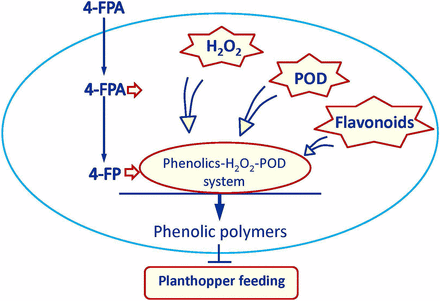A plant strengthener found to suppress insect pest populations, increases crop yields
The research team led by Prof. LOU Yonggen from the College of Agriculture and Biotechnology engaged in groundbreaking research in induced plant defenses for pest control. Their latest research findings are published in the May 20 issue of the journal of Proceedings of the National Academy of Sciences of the USA.
When subjected to attack from pests, crops will make specific defense responses via the recognition of damage- and herbivore-associated molecular patterns and modify defense signaling pathways. Plant strengtheners that induce defenses provide a potentially viable approach to controlling pests and reducing the use of pesticide.
To this end, Prof. LOU Yonggen worked in collaboration with Prof. WU Jun from the Department of Chemistry, Prof. Angharad Gatehouse from the University of Newcastle in the United Kingdom and Prof. Mathias Erb from the University of Bern in Switzerland. They discovered that 4-fluorophenoxyacetic acid (4-FPA)—a newly identified plant strengthener—can enhance the resistance of rice and other major cereals to sap-sucking insects by triggering the formation of flavonoid polymers in plant cells. Meanwhile, they found out that 4-FPA can effectively reduce the survivability of such sap-sucking insects as Sitobion avenae (the English grain aphid) and Rhopalosiphum padi (the bird cherry-oat aphid) in barley and wheat. Field experiments also revealed that spraying 4-FPA can successfully lower the population density of Sogatella furcifera (the white-backed planthopper) and increase crop yields.

Proposed model demonstrating the mode of action of 4-FPA in inducing the observed resistance of plants to piercing and sucking herbivores. Four-FPA can be absorbed by plants and is then immediately converted into 4-FP. Four-FPA alone or together with 4-FP induce the production of H2O2, peroxidases (PODs), and flavonoids. Four-FP and flavonoids are then catalyzed by PODs to form polymers using H2O2 as electron acceptors. Phenolic polymers in the parenchyma cells may inhibit the stylets of piercing and sucking from reaching the phloem sap in the plant sieve elements and/or may block the esophagus in the stylets, and hence inhibit feeding thus decreasing performance and survival of piercing and sucking herbivores.
This study reveals a novel mechanism by which plants resist piercing and sucking herbivores and shed a light on the design of a sustainable generation of plant strengtheners to control insect pests in agriculture.